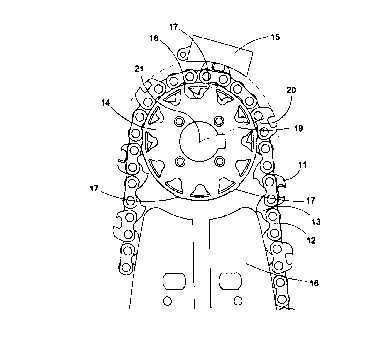Une partie des informations de ce site Web a été fournie par des sources externes. Le gouvernement du Canada n'assume aucune responsabilité concernant la précision, l'actualité ou la fiabilité des informations fournies par les sources externes. Les utilisateurs qui désirent employer cette information devraient consulter directement la source des informations. Le contenu fourni par les sources externes n'est pas assujetti aux exigences sur les langues officielles, la protection des renseignements personnels et l'accessibilité.
L'apparition de différences dans le texte et l'image des Revendications et de l'Abrégé dépend du moment auquel le document est publié. Les textes des Revendications et de l'Abrégé sont affichés :
| (12) Demande de brevet: | (11) CA 2295758 |
|---|---|
| (54) Titre français: | DISPOSITIF D'AFFUTAGE DE SCIES A CHAINE |
| (54) Titre anglais: | GRINDING DEVICE FOR CHAIN SAWS |
| Statut: | Réputée abandonnée et au-delà du délai pour le rétablissement - en attente de la réponse à l’avis de communication rejetée |
| (51) Classification internationale des brevets (CIB): |
|
|---|---|
| (72) Inventeurs : |
|
| (73) Titulaires : |
|
| (71) Demandeurs : |
|
| (74) Agent: | GOWLING WLG (CANADA) LLP |
| (74) Co-agent: | |
| (45) Délivré: | |
| (86) Date de dépôt PCT: | 1998-06-17 |
| (87) Mise à la disponibilité du public: | 1999-01-07 |
| Licence disponible: | S.O. |
| Cédé au domaine public: | S.O. |
| (25) Langue des documents déposés: | Anglais |
| Traité de coopération en matière de brevets (PCT): | Oui |
|---|---|
| (86) Numéro de la demande PCT: | PCT/SE1998/001176 |
| (87) Numéro de publication internationale PCT: | SE1998001176 |
| (85) Entrée nationale: | 1999-12-23 |
| (30) Données de priorité de la demande: | ||||||
|---|---|---|---|---|---|---|
|
L'invention concerne un dispositif d'affûtage de scies à chaîne. La chaîne est aiguisée par application d'un bloc abrasif (15) sur la face supérieure des maillons coupants (11) lorsque la chaîne défile autour d'une roue dentée de type jante (14). La périphérie généralement cylindrique de la roue d'entraînement possède des dents ou dents en biseau (17, 27) qui soulèvent l'extrémité frontale des maillons coupants (11). On obtient ainsi une profondeur de coupe suffisamment importante sans qu'il faille placer la cale étalon de profondeur loin devant le rivet frontal. Cela permet de réduire les vibrations et les instabilités de la chaîne lors du sciage.
Grinding device for chain saws, where the saw chain is sharpened b pressing an
abrasive block (15) against the top side of the cutter links (11) when the saw
chain is running around a rim type sprocket (14) and the generally cylindrical
periphery of the drive sprocket has raised steps or ramps (17, 27) which lift
the front end of the cutter links, thereby allowing a sufficiently large
cutting depth without locating the depth gauge far in front of the front
rivet. This reduces vibrations and instabilities of the saw chain when sawing.
Note : Les revendications sont présentées dans la langue officielle dans laquelle elles ont été soumises.
Note : Les descriptions sont présentées dans la langue officielle dans laquelle elles ont été soumises.

2024-08-01 : Dans le cadre de la transition vers les Brevets de nouvelle génération (BNG), la base de données sur les brevets canadiens (BDBC) contient désormais un Historique d'événement plus détaillé, qui reproduit le Journal des événements de notre nouvelle solution interne.
Veuillez noter que les événements débutant par « Inactive : » se réfèrent à des événements qui ne sont plus utilisés dans notre nouvelle solution interne.
Pour une meilleure compréhension de l'état de la demande ou brevet qui figure sur cette page, la rubrique Mise en garde , et les descriptions de Brevet , Historique d'événement , Taxes périodiques et Historique des paiements devraient être consultées.
| Description | Date |
|---|---|
| Demande non rétablie avant l'échéance | 2003-06-17 |
| Le délai pour l'annulation est expiré | 2003-06-17 |
| Réputée abandonnée - omission de répondre à un avis sur les taxes pour le maintien en état | 2002-06-17 |
| Inactive : Page couverture publiée | 2000-03-03 |
| Inactive : CIB en 1re position | 2000-03-02 |
| Lettre envoyée | 2000-02-22 |
| Inactive : Notice - Entrée phase nat. - Pas de RE | 2000-02-17 |
| Demande reçue - PCT | 2000-02-11 |
| Demande publiée (accessible au public) | 1999-01-07 |
| Date d'abandonnement | Raison | Date de rétablissement |
|---|---|---|
| 2002-06-17 |
Le dernier paiement a été reçu le 2001-06-18
Avis : Si le paiement en totalité n'a pas été reçu au plus tard à la date indiquée, une taxe supplémentaire peut être imposée, soit une des taxes suivantes :
Les taxes sur les brevets sont ajustées au 1er janvier de chaque année. Les montants ci-dessus sont les montants actuels s'ils sont reçus au plus tard le 31 décembre de l'année en cours.
Veuillez vous référer à la page web des
taxes sur les brevets
de l'OPIC pour voir tous les montants actuels des taxes.
| Type de taxes | Anniversaire | Échéance | Date payée |
|---|---|---|---|
| Enregistrement d'un document | 1999-12-23 | ||
| Taxe nationale de base - générale | 1999-12-23 | ||
| TM (demande, 2e anniv.) - générale | 02 | 2000-06-19 | 2000-05-25 |
| TM (demande, 3e anniv.) - générale | 03 | 2001-06-18 | 2001-06-18 |
Les titulaires actuels et antérieures au dossier sont affichés en ordre alphabétique.
| Titulaires actuels au dossier |
|---|
| KAPMAN AB |
| Titulaires antérieures au dossier |
|---|
| PER-OLOF LOFGREN |